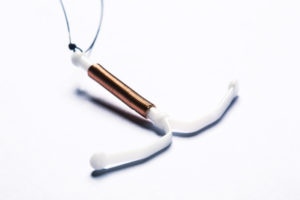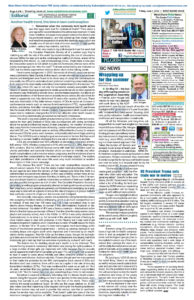EDITORIAL – June 1, 2018
Another health trend, this time in teen contraception
by Mary P Brooke, B.Sc., Editor, West Shore Voice News

Remember when the commonly held health advice was that eggs were bad for cholesterol levels? Then about a year ago (after several decades) the advice was reversed. It made news headlines, because many people believed the doctors and the promoted research, and had twisted up their dietary habits and mealtime preparation to avoid the dastardly eggs (which are actually one of nature’s best all-in-one sources of high-quality protein, various key vitamins, and iron).
Well, one needs to dig a bit deeper to hear this week that the Canadian Paediatric Society all of a sudden says they’re ‘catching up with the rest of the world’ by recommending the use of intrauterine devices (IUDs) for teen girls as the contraceptive method of choice, ahead of the longstanding first choice, i.e. oral contraceptives (OCs). [Note there is now also the intrauterine system or IUS which includes OC hormones.] Almost none of the media coverage got into ‘why this now?’ That was asked during one interview on CBC but the media-experienced medical doctor stuck to her talking points.
Here’s some background. In 2015, the results of a health measures survey were published by Stats Canada. In that report, women who self-declared as lower-income and immigrant were found to be more wary of using oral contraceptives (too costly, too difficult to understand) and preferred something presumably easier to do once and be more easily understood (mechanical insertion of a device). The report also linked OC use to not only the somewhat socially-acceptable health hazard of obesity (tipping progesterone levels upwards serves to relax ligaments as nature’s way of slowing a woman down, and increases appetite), but also to an increased incidence of the feared cancer (notably breast cancer, the rate of risk for which is apparently only fully diminished 10 years after ceasing OC use). There was also itemization of the better-known impacts of OCs to cause an increase in cardiovascular events such as venous thromboembolism (VTE), myocardial infarction, and stroke. And often not recognized is the imbalance that OC use throws into the levels of the body’s B vitamin-complex management which could in some cases lend to metabolic changes that in turn can allow for other health issues to evolve including metabolically-generated mental health imbalances.
This week’s big news splash about promoting IUDs as the preferred contraceptive for teen girls (instead of OCs) was accompanied with caring reminders about the social and financial impact of teen pregnancy. No mention of trying to step away from the increased rates of obesity, cancer and heart problems associated with OC use. That would open an entirely different kettle of worry for women who’ve used OCs for years, even decades, and possibly start some finger-pointing blame. This IUD/IUS push is being hung on socioeconomic factors. But they could be trading in women health’s wholesale from one set of problems to another.
IUDs are considered over 98% effective at preventing pregnancy and the IUS almost 100% effective (compared to 91% with combo OCs, 88% diaphragm, 82% condom). But the IUD/IUS devices come with their own problems such as uterine perforation and bacterial infection which can lead to infertility and other health complications (not to mention ectopic pregnancy and the incidence of some pregnancies then complicated by the presence of a foreign object). The doctors and clinic practitioners in the news this week very much minimized or avoided these topics in their promo campaign.
Why discuss this here? There are two main sociopolitical reasons that should concern people. First, that the widely trusted medical profession will have its own agenda and skew the delivery of their messaging to what they think is a well-intended socioeconomic strategy (in this case probably aimed more at low-income and immigrant populations than they’re letting on). Teens in the 21st century are a bright bunch but could be misled here on matters of their own health and are also possibly being used as a bit of a foil. The Canadian Paediatric Society is generating an entire program presumably directed at dealing with issues surrounding teen pregnancy (which people are generally comfortable acknowledging) as a sideways way to deal with an agenda to reduce the rate of pregnancy in groups that are less politically correct to single out: low income and immigrant.
And secondly, once again, women are (potentially) being herded like sheep into accepting the latest medical philosophy, which is as much sociopolitical as it is medical. It was less than 100 years ago that it was considered okay to use electric shock therapy therapy on women if they demonstrated ‘hysteria’ or ‘abnormal behaviour’; the sister of JFK was a famous example — lobotomized at her father’s direction because she was ‘different’ from the other Kennedy women (more playful and sexually active). And in the 1950s to 1970s it was pretty standard for hysterectomies to be done (i.e. full removal of the uterus) instead of looking for more holistic ways to deal with problems. In the Playboy era it was cool to get breast enlargement implants which created any number of health issues for many women. In the last 10 to 15 years it’s been transvaginal mesh technology at the height of troublesome gynecological woes — ending up causing damage to surrounding tissue and organs (both while implanted and if removed by an insufficiently skilled surgeon). Now it’s IUDs as the latest craze, though the technology’s been around since the 1970s (with health professionals now saying that IUDs mistakenly got a bad rap that has somehow mysteriously endured ‘until now’).
 The bottom line for deciding about one’s health is to be informed. That means having access to necessary information and asking the right questions. If a large number of teen girls are implanted with IUDs because they’re sexually active (apparently that’s half of Canadian girls age 17+), we shouldn’t be surprised to hear in years to come about infertility and other problems related to uterine perforation and infection. And not only that, if teens (the girl and her male partner) in their haste feel protected by the 98% contraceptive track record of IUDs and therefore don’t use condoms, there will in turn be a spike in the rate of sexually transmitted infections (STIs). That was mentioned this week as an add on: “And oh yeah, remember that your partner should use a condom even if you’re fitted with an IUD.” But it’s human nature to skip something if you think it’s not needed.
The bottom line for deciding about one’s health is to be informed. That means having access to necessary information and asking the right questions. If a large number of teen girls are implanted with IUDs because they’re sexually active (apparently that’s half of Canadian girls age 17+), we shouldn’t be surprised to hear in years to come about infertility and other problems related to uterine perforation and infection. And not only that, if teens (the girl and her male partner) in their haste feel protected by the 98% contraceptive track record of IUDs and therefore don’t use condoms, there will in turn be a spike in the rate of sexually transmitted infections (STIs). That was mentioned this week as an add on: “And oh yeah, remember that your partner should use a condom even if you’re fitted with an IUD.” But it’s human nature to skip something if you think it’s not needed.
Somehow it seemed particularly infuriating that it’s female health professionals doing the big push (selling out one’s own gender) to this new craze, even saying that Canada is just ‘catching up’ to the rest of the world. That’s really working the social acceptance factor. So let’s say the craze catches on. It was also made clear that implanting IUDs requires training for the health practitioner, that some doctors may not want to provide that service, and that in rural/north areas the service may not be available. That doesn’t quite take care of the low-income or immigrant objective, or fulfill Canada’s apparent objective of universal available health care.
If women using OCs presently have a high risk for health complications or end up pregnant in low-income and immigrant groups (due to incomplete/incorrect use of the medication) then perhaps it’s more of a call for a fully-funded pharmacare program in Canada, and a better level of funding for clinic-level health education programs.
By jazzing up IUD/IUS use as the latest thing, there’s an attempt as well to reduce overall costs to both user and provider (do it once and it’s done). But the prediction here is that this will come back to bite the health profession and many of the young women who trust and follow this latest fad in reproductive management.
And the elephant in the room is that women still unduly bear the primary responsibility for reproductive decisions, especially outside of a stable long-term relationship.
This editorial was first published in the June 1, 2018 print/PDF edition of West Shore Voice News, page 2.
Back to Editorial section | Back to the Main Page of West Shore Voice News

